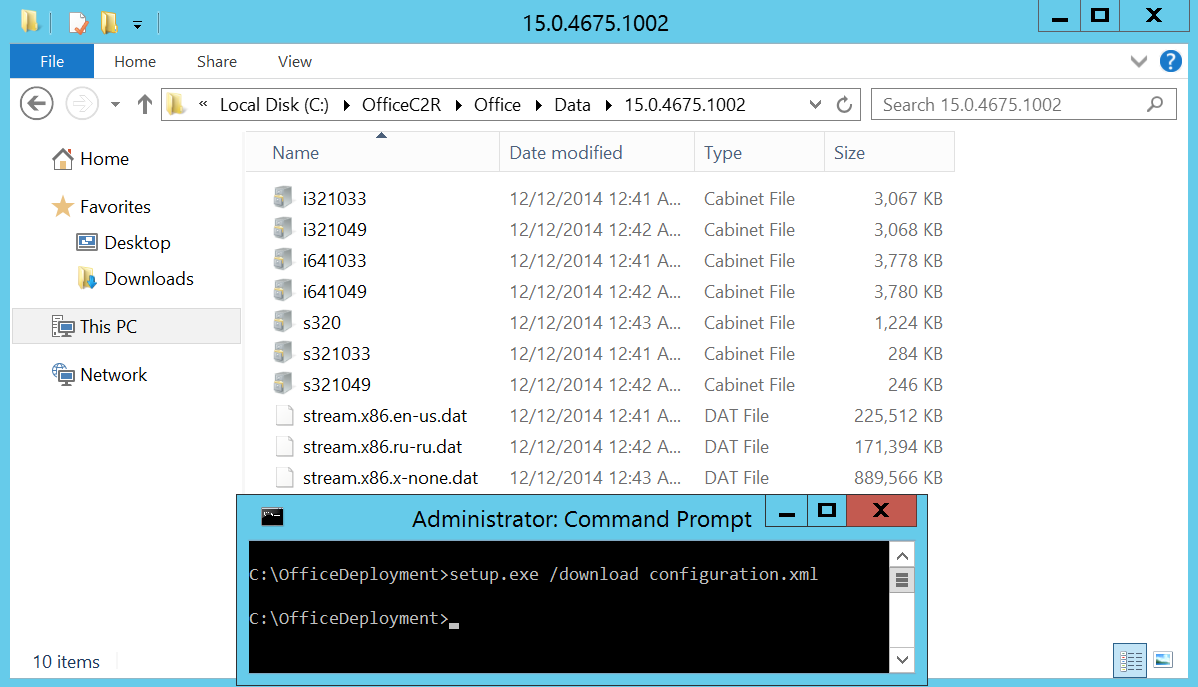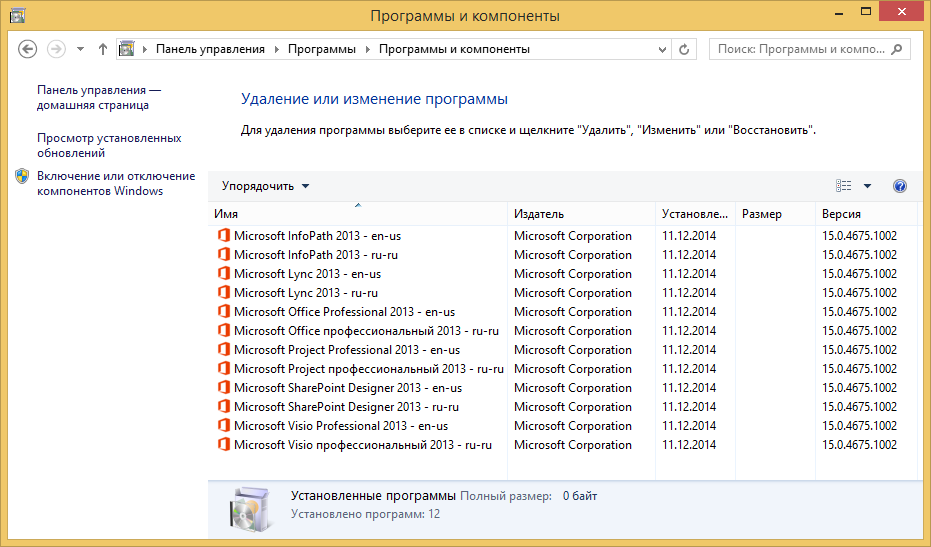How to download the latest Office from Microsoft without any App-V
Last week, I wrote a note, “How to Download Office 2013 Virtual Corporate from Microsoft,” which described how to use the Office Deployment ToolDownload the latest enterprise version of Office 2013 and convert it to the virtual package format APP-V 5.0. It is obvious that application virtualization is interesting for mass deployment, for terminal access farm scenarios, and for enthusiasts who often update the OS on their home PC, for example, installing regular Windows 10 builds using the Windows Insider program, and not wanting to manually reinstall all applications. For a simpler user, there is a completely trivial scenario for installing Microsoft Office with the same Deployment Tool in Click2Run mode. There are two differences from the method described in the last note. Firstly, you do not need to convert the package to the APP-V format (accordingly, you do not need APP-V itself and manipulations in PowerShell) - right after downloading the package, we will prepare it for Click2Run using one command. The second difference will be more sad - only Retail versions of Office 2013 are available for the Click2Run operating mode - therefore, the product will need to be activated manually. Consider the process step by step.
To get started, still load the Office Deployment Tooland unpack it. As well as in the case of corporate versions, where in addition to Office Professional Plus I wanted to have Visio Pro and Project Pro, as well as the ability to work with the Russian and English interface of the product, I will try to get a complete list of products in Retail editions. Alas, Office Professional Plus is only available for Office 365 customers and subscribers, it is not possible to download the Retail version of Click2Run, it simply does not exist. However, a version of Office Professional is available that is distinguished by the absence of Lync and InfoPath. For example, I will load Lync and InfoPath separately in the Retail version, adding them to the configuration file. There I will add SharePoint Designer, which is available only in the Retail Edition for Click2Run downloads. I will also proceed from the recommendation of Microsoft to use a 32-bit version of office products in desktop configurations. The main difference between the fileconfiguration.xml from the previous one will be in the Product IDs responsible for the choice of edition. Remember that corporate versions are intended for use with APP-V, and only Retail versions can be used without it in Click2Run mode. In your example, you can remove unnecessary products, leave one language, or change the length of office products from 32 to 64 by editing the example file below.
Having saved the configuration.xml file , I start the process of downloading the package by running the command:

I would like to note that a week ago, when I downloaded the corporate version of Office 2013 with the same team, I received build 15.0.4667.1002 from the November 2014 Office Update Release , and today it is already loading 15.0.4675.1002 from the December update (there are no links yet at the time of writing this note) . Naturally, if today you step by step follow the steps to download the corporate version, which I described in the article “ How to download virtual corporate Office 2013 from the Microsoft website ”, you will also receive an updated assembly.
Since we downloaded the Retail version of the package, the Office Deployment Tool will help us install Click2Run for use without further action, simply by running the command:
The process takes several minutes, showing us the progress of execution:

Note that the English language of the inscription for me arises because of the English interface language of my Windows 10. The programs themselves are already available, although the wizard is still running.

In the menu I can already select and run them:

Since the Retail version, activation is required either by entering the serial number, or by specifying an account with an Office365 subscription, otherwise the product will go into limited mode of operation.

Enter your serial number and activate the product. Those who have fewer keys than computers remember the recommendation to turn off the network and activate the office by phone.
Since I indicated two languages and a large number of applications in the configuration file, the list of installed software is impressive, you can reduce it by editing configuration.xml before downloading and installing.

I think that this method of installing Office is convenient primarily for those who want to immediately get the latest version of the product, without installing dozens of updates after, and also install a lot of products in the required languages at once without searching and downloading individual distributions. I’ll talk more about installing Office 2013 using the Deployment Tool using the Office virtualization webcast and the latest Microsoft Application Virtualization 5.0 SP3. To those interested I suggest registering for participation by reference , there I will be ready to promptly answer questions on this topic.
To get started, still load the Office Deployment Tooland unpack it. As well as in the case of corporate versions, where in addition to Office Professional Plus I wanted to have Visio Pro and Project Pro, as well as the ability to work with the Russian and English interface of the product, I will try to get a complete list of products in Retail editions. Alas, Office Professional Plus is only available for Office 365 customers and subscribers, it is not possible to download the Retail version of Click2Run, it simply does not exist. However, a version of Office Professional is available that is distinguished by the absence of Lync and InfoPath. For example, I will load Lync and InfoPath separately in the Retail version, adding them to the configuration file. There I will add SharePoint Designer, which is available only in the Retail Edition for Click2Run downloads. I will also proceed from the recommendation of Microsoft to use a 32-bit version of office products in desktop configurations. The main difference between the fileconfiguration.xml from the previous one will be in the Product IDs responsible for the choice of edition. Remember that corporate versions are intended for use with APP-V, and only Retail versions can be used without it in Click2Run mode. In your example, you can remove unnecessary products, leave one language, or change the length of office products from 32 to 64 by editing the example file below.
Having saved the configuration.xml file , I start the process of downloading the package by running the command:
setup.exe /download configuration.xml
I would like to note that a week ago, when I downloaded the corporate version of Office 2013 with the same team, I received build 15.0.4667.1002 from the November 2014 Office Update Release , and today it is already loading 15.0.4675.1002 from the December update (there are no links yet at the time of writing this note) . Naturally, if today you step by step follow the steps to download the corporate version, which I described in the article “ How to download virtual corporate Office 2013 from the Microsoft website ”, you will also receive an updated assembly.
Since we downloaded the Retail version of the package, the Office Deployment Tool will help us install Click2Run for use without further action, simply by running the command:
setup.exe /configure configuration.xmlThe process takes several minutes, showing us the progress of execution:

Note that the English language of the inscription for me arises because of the English interface language of my Windows 10. The programs themselves are already available, although the wizard is still running.

In the menu I can already select and run them:

Since the Retail version, activation is required either by entering the serial number, or by specifying an account with an Office365 subscription, otherwise the product will go into limited mode of operation.

Enter your serial number and activate the product. Those who have fewer keys than computers remember the recommendation to turn off the network and activate the office by phone.
Since I indicated two languages and a large number of applications in the configuration file, the list of installed software is impressive, you can reduce it by editing configuration.xml before downloading and installing.

I think that this method of installing Office is convenient primarily for those who want to immediately get the latest version of the product, without installing dozens of updates after, and also install a lot of products in the required languages at once without searching and downloading individual distributions. I’ll talk more about installing Office 2013 using the Deployment Tool using the Office virtualization webcast and the latest Microsoft Application Virtualization 5.0 SP3. To those interested I suggest registering for participation by reference , there I will be ready to promptly answer questions on this topic.
